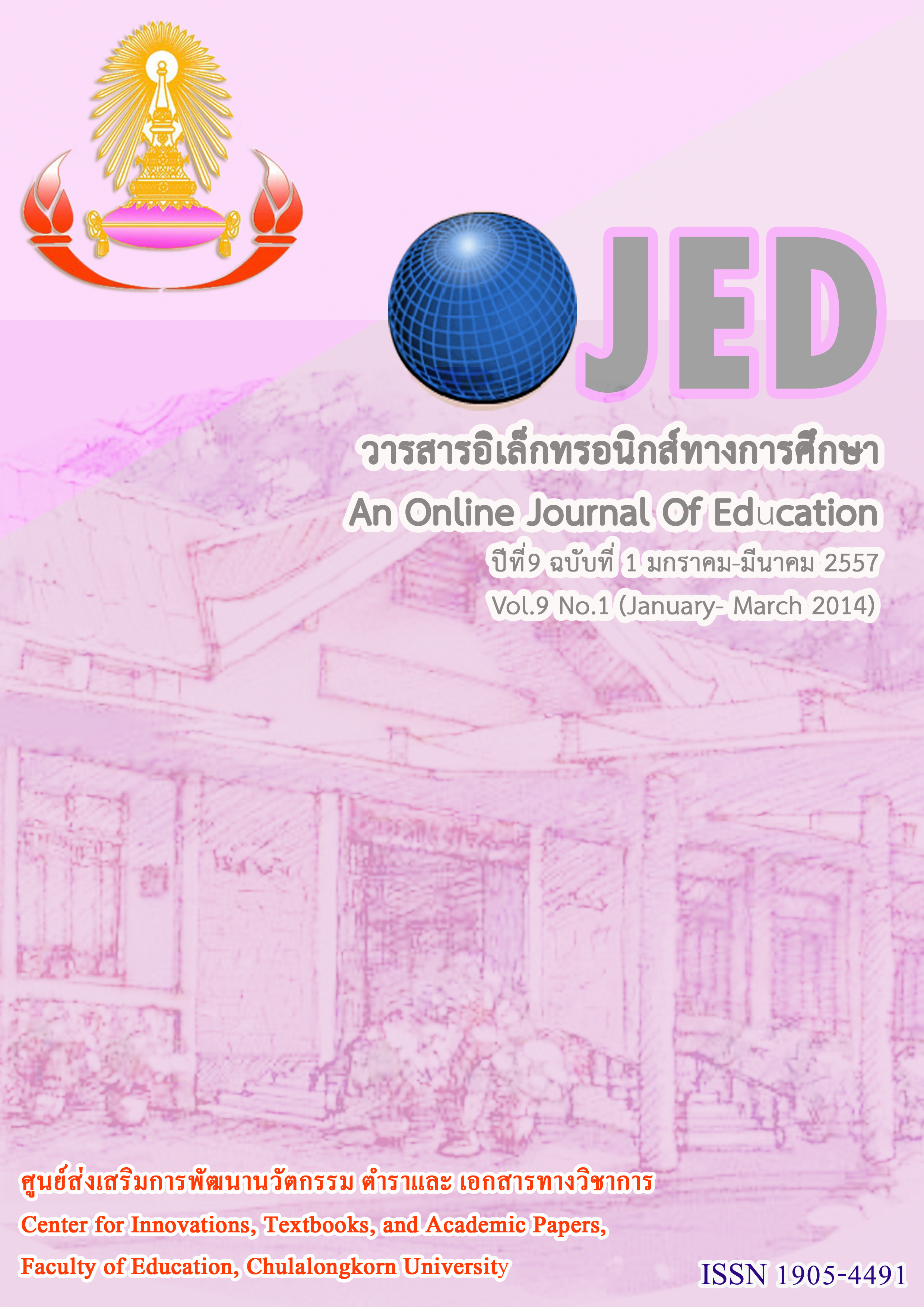ผลของการใช้แผนภูมิความคิดต่อการวัดความสามารถในการอ่านภาษาอังกฤษของนักเรียน ชั้นประถมศึกษา
Keywords:
แผนภูมิความคิด, ความสามารถในการอ่าน, นักเรียนระดับอายุ 6-12 ปี, การเรียนการสอนวิชาการอ่านภาษาอังกฤษ, GRAPHIC ORGANIZERS, COMPREHENSION ABILITY, YOUNG LEARNERS, ENGLISH READING INSTRUCTIONAbstract
การฝึกใช้แผนภูมิความคิดในขณะเรียนการอ่านนับเป็นการใช้เครื่องมือเพื่อช่วยอ่านที่เหมาะสมกับนักเรียนประถม จากงานวิจัยที่ผ่านมา (McKnight, 2010 and Willis, 2008) พิสูจน์ว่าแผนภูมิความคิดเข้ากับการทำงานของสมองในแง่ของการช่วยถอดความให้เป็นข้อมูลภาพ นอกจากนี้งานวิจัยอื่นๆ (Cox, 2011and McKnight, 2010) ยังยืนยันผลของนักเรียนที่ฝึกใช้แผนภูมิความคิดในการอ่านว่าสามารถเชื่อมโยงเนื้อหาในบทอ่านได้ดีขึ้น ดังนั้นงานวิจัยฉบับนี้มีวัตถุประสงค์เพื่อศึกษาผลของการการสอนอ่านภาษาอังกฤษโดยใช้แผนภูมิความคิดที่มีต่อความสามารถในการอ่านของนักเรียนชั้นประถมศึกษาปีที่ 5 นอกจากนี้ยังได้สำรวจความคิดเห็นเกี่ยวกับการใช้แผนภูมิความคิดในชั้นเรียนวิชาการอ่านภาษาอังกฤษของนักเรียนกลุ่มดังกล่าวด้วย กลุ่มประชากรตัวอย่างประกอบด้วยนักเรียนชั้นประถมศึกษาปีที่ 5 จำนวน 34 คนจากโรงเรียนเอกชนแห่งหนึ่งในกรุงเทพฯ ในภาคเรียนที่ 2 ปีการศึกษา 2556 เครื่องมือที่ใช้สำหรับการสอนในครั้งนี้ได้แก่แผนภูมิความคิดซึ่งประกอบด้วยแผนภูมิจำนวน 5 แบบ ได้แก่แผนภูมิแบบ Timeline, Descriptive, Compare-and-Contrast, Cause-and-Effect และ Problem-and-Solution แผนภูมิทั้ง 5 แบบนี้นำมาใช้เพื่อจุดประสงค์ในการพัฒนาความสามารถด้านการอ่านสำหรับเด็กเล็ก งานวิจัยนี้ใช้ทั้งเครื่องมือในการสอนได้แก่แผนการสอนการอ่านภาษาอังกฤษโดยใช้แผนภูมิความคิดเป็นเครื่องมือในการอ่าน และเครื่องมือสำหรับการเก็บข้อมูลได้แก่แบบทดสอบการอ่านวัดความเข้าใจฉบับก่อนเรียนและหลังเรียน (แบบคู่ขนาน) และแบบสอบถามความพึงพอใจต่อการใช้แผนภูมิความคิดซึ่งใช้ในชั้นเรียนการอ่านภาษาอังกฤษนี้ ระยะการทดลองใช้เวลาทั้งสิ้น 13 สัปดาห์ สถิติที่ใช้ในการวิเคราะห์ความสามารถในการอ่านก่อนและหลังการทดลอง และการวิเคราะห์ความพึงพอใจเกี่ยวกับการใช้แผนภูมิความคิดในชั้นเรียนวิชาการอ่านภาษาอังกฤษคือ Descriptive Statistics และ Paired sample t-test
ผลการวิจัยพบว่า 1) นักเรียนได้คะแนนเฉลี่ยจากแบบทดสอบการอ่านหลังการทดลอง(=11.82, S.D.=3.25) ซึ่งสูงกว่าคะแนนเฉลี่ยก่อนการทดลอง (=10.44, S.D.=3.23) อย่างมีนัยสำคัญทางสถิติที่ระดับ 0.05 โดยมีค่าขนาดของอิทธิพลในระดับปานกลาง (d = 0.43) 2) จากการสำรวจความพึงพอใจเกี่ยวกับการใช้แผนภูมิความคิดในชั้นเรียนวิชาการอ่านภาษาอังกฤษ พบว่า นักเรียนมีความพึงพอใจต่อการใช้แผนภูมิความคิดทั้งในแง่ของการความพึงพอใจทั่วไป (=2.17, S.D.= .646) และในแง่ของความพึงพอใจที่แผนภูมิความคิดสามารถช่วยให้เกิดความเข้าใจในการอ่านเพิ่มขึ้น (=2.20, S.D.= .670) โดยพิจารณาตามเกณฑ์ Likert Scale (three-point Likert Scale)
Graphic organizer used in reading instruction is claimed as an appropriate reading tool for young learners. According to the previous studies (McKnight, 2010 and Willis, 2008), the findings claimed that graphic organizers were compatible with the brain in term of helping equip the brain to interpret meanings from images better than texts. In addition, many studies (Cox, 2011and McKnight, 2010) supported that many young learners who employed graphic organizers in reading were able to identify the connection and the content of the texts better. Consequently, the current study aimed to explore effects of graphic organizers on English reading ability of fifth grade students as well as to examine the satisfaction with using graphic organizers in the English reading course. The participants were 34 fifth-grade Thai elementary school students at a private school in Bangkok in the second semester of the academic year 2013. Five types of graphic organizers: Timeline, Descriptive, Compare-and-Contrast, Cause-and-Effect and Problem-and-Solution organizers were employed in the current study to enhance the young learners’ reading comprehension ability. Two instruments were used in this study, firstly, the instructional instrument including lesson plan and, secondly, the research instruments including the English reading comprehension pretest and posttest (parallel forms), and the opinion questionnaire. The implementation lasted for 13 weeks. The collected data were analyzed using descriptive statistics to obtain means and standard deviations, including the paired sample t-test.
The findings revealed that 1) the participants gained higher scores on the English reading comprehension ability posttest (=11.82, S.D.=3.25) than the pretest (=10.44, S.D.=3.23) at the 0.05 significant level with the medium effect size (d = 0.43). 2) According to the opinion questionnaire, the participants were generally impressed about using Graphic Organizers in reading instruction (=2.17, S.D.= .646). Moreover, the participants thought that graphic organizers really helped them to see the text structures and comprehend reading passages better (=2.20, S.D.=.670).




